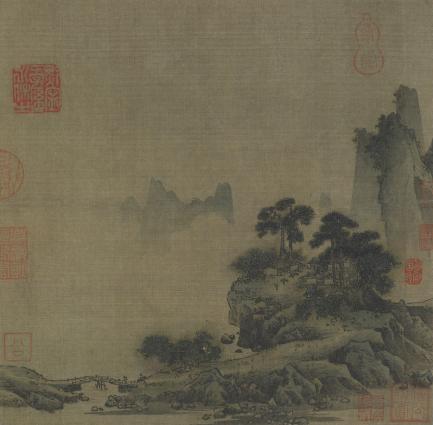Rare Chinese Landscape Paintings Return to View at Smithsonian’s Freer Gallery of Art
For generations of painters and admirers, rare and seldom-displayed landscape painting from China’s Song dynasty rank among the most outstanding achievements of Chinese culture. On view May 17–Oct. 26, “Style in Chinese Landscape Painting: The Song Legacy” presents an unprecedented array of more than 30 exemplary works, selected from the collection of the Freer Gallery of Art. The exhibition represents one of the finest groupings of such masterpieces outside of Asia, and it is the first exhibition to specifically address Song Dynasty painting styles and traditions at the Freer in 30 years.
While landscape painting has a long history in China, reaching back to the third and fourth centuries, it was during the roughly 400-year period from the mid-10th to the mid-14th centuries that the most iconic styles and techniques emerged. “Style in Chinese Landscape Painting” examines the six distinct stylistic traditions that evolved during the Song dynasty (920–1279), the pinnacle of Chinese landscape painting, and traces their influential legacy through the centuries.
“The Freer’s extraordinary collection is well suited to address the important yet often little-understood subject of style in Song dynasty landscape paintings,” said Stephen Allee, associate curator for Chinese painting and calligraphy at the Freer Gallery of Art and Arthur M. Sackler Gallery. “Wherever possible, we’re able to present the earliest examples of each style in the museum collection. Together, these rare works tell the story of Chinese landscape painting, as many styles from the period are still practiced today.”
Surviving works from many Song dynasty masters are either extremely rare or non-existent, and the particularities of their individual styles—identified by variations in compositional approach, the tonalities of ink and the particular use of brushstrokes to create an illusion of surface texture—are known today only through later copies or the works of aspiring followers. Differentiated by the features above, and generally named after the masters of each style, six styles are featured in the exhibition including the blue-and-green style, Dong Yuan-Juran style, Fan Kuan-Li Tang style, Li Cheng-Guo Xi style, Mi Family style and Ma Yuan-Xia Gui style. Many of the most enduring techniques and approaches in Chinese landscape painting evolved from these innovative styles.
As the foremost landscape painter in the Jin dynasty, and a follower of the Li Cheng-Guo Xi style, Li Shan created “Wind and Snow in the Fir-pines”—the only genuine work by Li Shan still in existence. Also on view is a section from “Ten Thousand Li Along the Yangzi River,” which spans more than 54 feet and is the only surviving painting from the Song dynasty that depicts the full length of the Yangtze River.
Charles Lang Freer, the founder of the Freer Gallery, recognized the Song dynasty to be the golden age of Chinese landscape painting, and was instrumental in the dramatic resurgence of Western interest in Chinese painting in the early 20th century. He was an avid collector, and a majority of the exhibition include works that were part of his original gift to the Smithsonian. One of the most famous, “Clearing Autumn Skies over Mountains and Valleys,” is one of the earliest surviving handscrolls in the Li Cheng-Guo Xi style, which depicts the idea of a landscape rather than its actual appearance.
A subsequent exhibition of Yuan dynasty (1279–1368) landscape paintings will open in November, continuing the exploration of stylistic traditions. In addition, an online resource created by Freer and Sackler researchers, Song and Yuan Painting and Calligraphy, contains hundreds of images and comprehensive documentation of the Freer’s exceptional holdings of 85 works of Chinese brushwork from the 10th through the 14th centuries.
The Freer Gallery of Art, located at 12th Street and Independence Avenue S.W., and the adjacent Arthur M. Sackler Gallery, located at 1050 Independence Avenue S.W., are on the National Mall in Washington, D.C. Hours are 10 a.m. to 5:30 p.m. every day (closed Dec. 25), and admission is free. The galleries are located near the Smithsonian Metrorail station on the Blue and Orange lines. For more information about the Freer and Sackler galleries and their exhibitions, programs and other public events, visit www.asia.si.edu. For general Smithsonian information, call (202) 633-1000.
# # #
SI-218-2014


